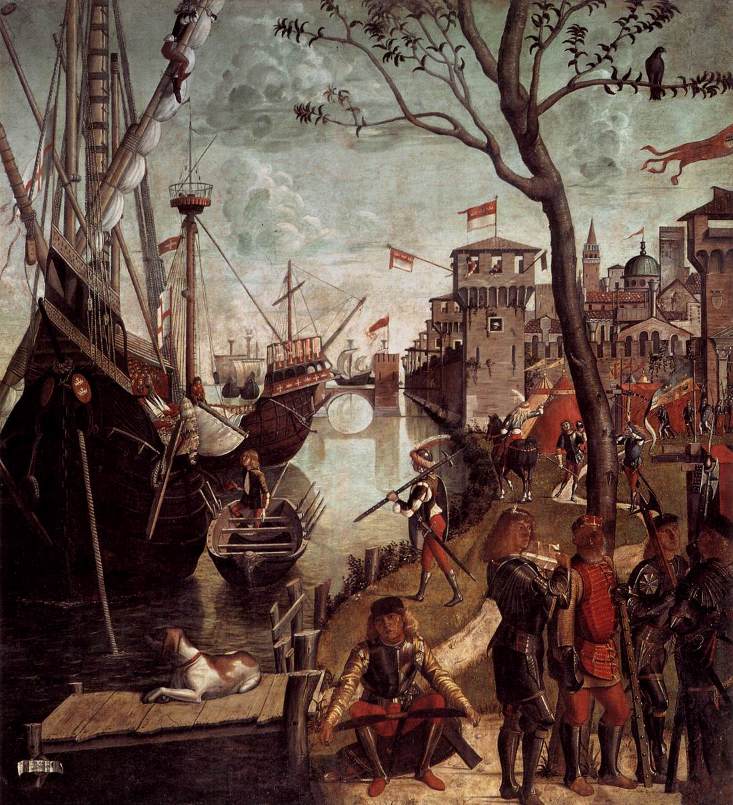Join Amazon Prime - Watch Thousands of Movies & TV Shows Anytime - Start Free Trial Now

Join Amazon Prime - Watch Thousands of Movies & TV Shows Anytime - Start Free Trial Now
The Pilgrims' Arrival in Cologne, the Life of St Ursula
by Vittore Carpaccio, 1490-96

A larger image of The Pilgrims' Arrival in Cologne, the Life of St Ursula, by Vittore Carpaccio, 1490-96. Gallerie dell'Accademia, Venice, Italy.
CARPACCIO, Vittore
(b. 1472, Venezia, d. 1526, Capodistria)
The Arrival of the Pilgrims in Cologne
Tempera on canvas, 280 x 255 cm
Gallerie dell'Accademia, Venice
Canvas No. 7 of the series of nine large paintings "Stories from the Life of St Ursula".
In the scene of the Pilgrims' Arrival in Cologne some details of the event are relegated to marginal positions.
While in the distance some of the vessels of the retinue are still out at sea,
to the left the flagship has already docked; Ursula and Pope Cyriacus lean out to ask information from a boatman.
To the right, in the foreground, four armed envoys have just finished reading out the message warning the Hun princes of the arrival of the Christian pilgrims.
Carpaccio does not really demonstrate great self-assuredness in the composition of the scene or in the way the individual events are related to one another.
But we can already begin to make out the characteristic features of his visual language: the slow, almost magically suspended rhythm of the narration,
fixed in its most salient moment; the attention to the lighting of even the smallest details; the extraordinary brightness of the colours.
The event is portrayed in a fresh and lively scene of movement. At the top, the vessel's pennant and the mast are cut off abruptly,
while to the left there is the suggestion of a vast expanse of water and to the right the urban density of Cologne.
The setting is reminiscent of a misty autumn morning in Venice.
In the greyish light the ships glide slowly over the still water,
reaching the harbour just outside the city walls depicted in perspective towards a vanishing point on the horizon:
this whole part of the scene looks very much like the older sections of the Arsenal in Venice.
Carpaccio was an Italian painter of the Venetian school, who studied under Gentile Bellini (1429 – 1507).
He is best known for a cycle of nine paintings, called The Legend of Saint Ursula for the Venetian Scuola and now in the Accademia of Venice.
He was influenced by the style of Antonello da Messina (1430 – 1479) and Early Netherlandish art.
The Stories from the Life of St Ursula (1490-96)
by Vittore CARPACCIO
In 1488 the Confraternity of St Ursula in Venice decided to commission a series of large canvases recounting the story of St Ursula.
Vittore Carpaccio was commissioned to do the work.
The legend of the northern saint Ursula was extremely popular in the Middle Ages and had been the subject of several pictorial cycles.
Carpaccio drew his inspiration for the cycle from the Lives of the Saints (Legenda Aurea) published in Venice in an Italian translation in 1475.
In painting the nine canvases, today in the Accademia in Venice, Carpaccio was not able to follow the chronological order of the story,
he was forced to paint the scenes in the order that the wallspace was available for him. He begun working in 1490 and completed the cycle in 1496.
The elements of the story: the arrival of the ambassadors of the pagan King of England at the Court of the Christian King of Brittany,
to ask for the hand of his daughter Ursula for the son of their Lord (canvas No. 1);
the conditions Ursula sets out before accepting the marriage proposal (canvas No. 2);
the ambassadors return to the English Court (canvas No. 3);
the farewells and Ursula's pilgrimage (canvas No. 4);
the dream in which Ursula is forewarned of her martyrdom (canvas No. 5);
her encounter with Pope Cyriacus in Rome (canvas No. 6);
her arrival in Cologne, occupied by the Huns (canvas No. 7);
the slaughter of the pilgrims and Ursula's funeral (canvas No. 8);
St Ursula in glory above the host of martyrs (canvas No. 9).
Source: The Stories from the Life of St Ursula (1490-96) by Vittore CARPACCIO, Web Gallery of Art
Venetian Foot Soldiers in Armies of the Middle Ages, Volume 2 by Ian Heath, based on "The Pilgrims' Arrival in Cologne, the Life of St Ursula" by Vittore Carpaccio, 1490-96
See also a detail from the Martyrdom of the Pilgrims, the Life of St Ursula, by Vittore Carpaccio, 1490-96
Group of Italian Soldiers and Men in Oriental Costume, by Vittore Carpaccio, between 1493 and 1500
Back to Paintings of Italian Soldiers of the mid to late 15th Century

